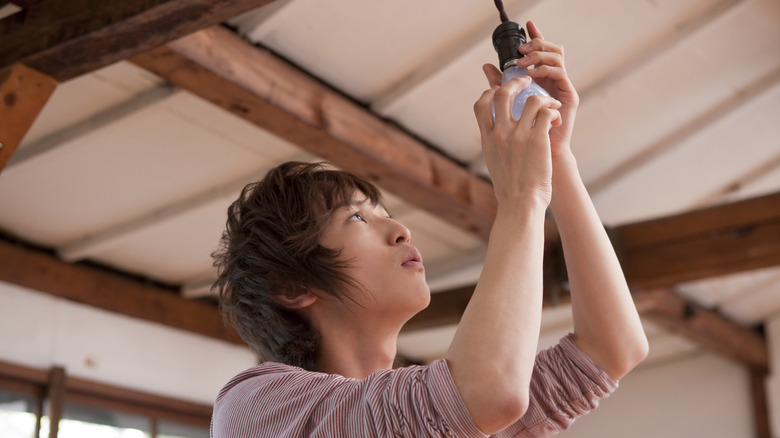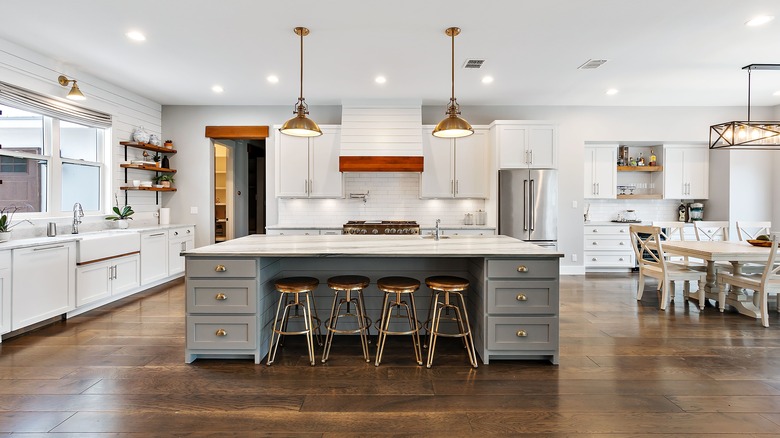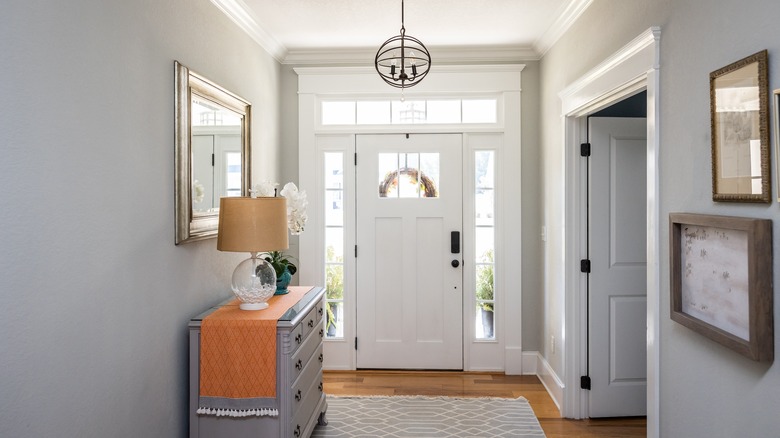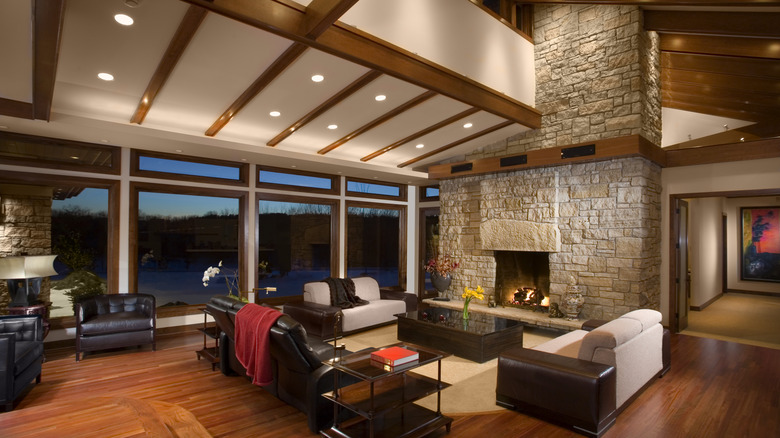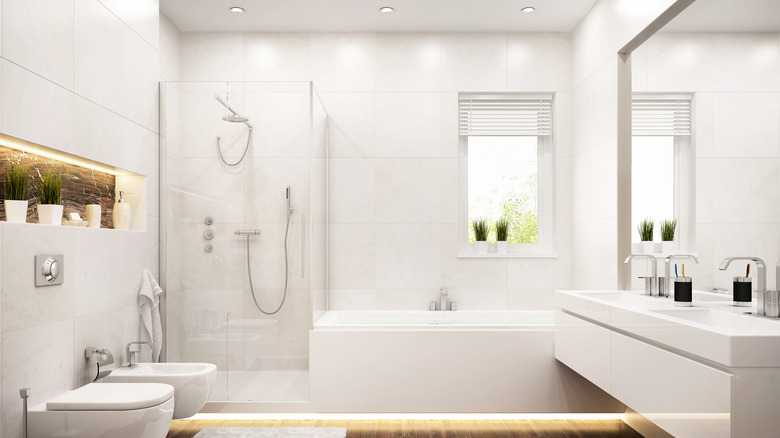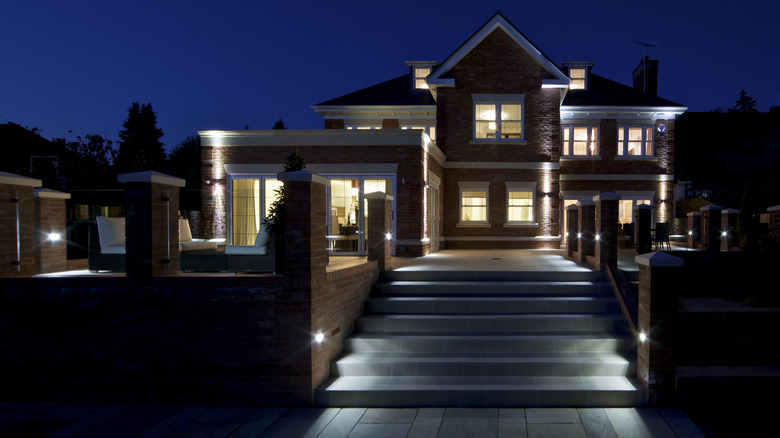Overlooked Spots In Your Home That Are Begging For Better Lighting
Good lighting in a room is a balance among sources, the room's furnishings and textures, and your particular uses and preferences. Any room you didn't design specifically for yourself might not strike quite the right balance for you... and the lighting in some rooms (bathrooms come to mind) often doesn't really work for anyone. Lighting frequently gets overlooked when we focus on the overall appearance of a room or on just one aspect of using the room, neglecting others. It's easy, for example, to neglect task lighting in a living room when we're focused on it as a space for the whole family. There are neglected nooks like this throughout most houses that could use a little lighting help.
It's always tempting to think of more lighting as a solution when, in fact, what the room needs is better lighting. As we'll see, good lighting is more subtle — less glaring, you might say — than that. Rather than more light, you might need different types of lighting for different functions; we commonly break these down into categories like ambient, task, decorative, and accent lighting. Try to keep all these needs in balance, and use dimmers wherever you can to manage different lighting needs between day and night. Also, avoid mixing color temperatures to temper the tendency toward chaos in a room with complicated lighting. Try to stick with soft white bulbs.
In kitchen work areas
Kitchens need a lot of light, and some of that light serves very specific purposes. As in most rooms, layering is the best lighting strategy for your kitchen and is the key to an overall satisfying kitchen lighting scheme. We typically describe the modes of kitchen lighting with terms like decorative, multi-function, under-counter, and ambient lighting (including overhead). There's a lot of overlap, of course; lights within cabinets can provide additional ambient light while obviously serving both decorative and practical purposes. Statement lighting, sometimes in the form of a dramatic pendant light, can add ambient light while creating visual interest.
The most common kitchen lighting problem is that the necessary light simply isn't in the right place. On countertop workspaces, this can often be either additional task or under-cabinet lighting. If you're trying to retrofit lighting into a kitchen, especially in a rental or on a budget, some strategies can help. Drafting lamps — those movable desk lamps on scissoring arms or booms — can add stylish lighting when you don't have access to in-wall wiring. You can also use carefully placed table lamps for both task and ambient lighting, and color-controllable LEDs provide great mood lighting in a kitchen. LED strip lights, especially, have made under-cabinet lighting so easy that you've probably thought of it already.
In hallways
If we were to say your hallway has bad or insufficient lighting, most people would nod in agreement, even if they hadn't really considered it before. However, hallways are important spaces you occupy many times a day, and new guests experience them as a conduit, moving them from discovery to discovery within your home. It's the sort of space that invites creative solutions. The restricted size and relative lack of furnishing can make hallways a challenge to light well, so your main strategy might be to do everything you can to visually enlarge the room and add points of visual interest. Avoid large furniture and obtrusive pendant lights; the size will only diminish a small space. But use large mirrors and artwork, with the latter hung high on the hallway wall.
Wall art is a great boon for giving hallway lighting an ostensible purpose. Using wall sconces above artwork is a good example, but you might get even more from carefully selected track lighting, with some lights aimed at wall art and others providing general illumination. Replacing an existing fixture with track lighting is a great solution when you can't add more lights to a room or hallway. Use floor lamps to lighten corners. And use glass panes in hall doorways, especially doors to rooms with plenty of natural light. You'll obviously want to use gauzy or otherwise transparent window treatments in those rooms to allow in as much light as possible.
In the living room
The actual lighting needs of a living room are driven by your specific layout and needs, but the same common problems tend to crop up. The most frequent of these might be lighting designed to complement bright daylight and to keep out of the way on dimly lit nights spent by the fireplace or television. The trouble is that many things we do in our living rooms require more intentional lighting than that, in the usual categories like ambient, accent, decorative, and task lighting in the usual forms: ceiling fixtures, floor lamps, table lamps, etc. Pay attention to all the possible sources of light for any given sitting area or workspace within the living room. The sources might be dim, so plan for lots of task lighting and multiple sources for spaces like corners. Consider using stylish statement lighting to brighten up your living room.
Using task lighting to illuminate local areas within a living room is a given, and you can accomplish a lot of it with judiciously placed lamps. But don't neglect how important background ambient lighting can be to achieving the right light levels, and make liberal use of dimmers. If it's dark or overcast, dim ambient lights for gentler task lighting or mood lighting. Accent lighting is not usually functional, so it is an ideal avenue for simultaneously expressing yourself and surrounding yourself with things you love while getting more ambient light in the room.
Over your toilet and tub
The most common problem with bathroom lighting is that there simply isn't enough of it, and it tends to be focused on the vanity, leaving the shower or tub in relative darkness. Factors like budget, rental deposits, and the prevalence of tile can make opening up walls and ceilings to add light a challenge, but you can still take action to make the best of what light you can muster. Obviously, you'll want to make the most of any natural lighting from windows by minimizing window coverings — or eliminating them entirely, if privacy isn't a concern. Also, update your existing fixtures and seek replacements to cast more light around the room. As always, if you have the option, make use of dimmers and multiple switches to control the light in your bathroom more finely — and keep bulbs bright and in the 2700K to 3000K color temperature range.
Vanity lighting might seem like the source of your bathroom problems, but it can also be your ally. Obviously, more (and more directional) light is better — except when you must keep above-the-mirror vanity lights, in which case, you should look for a fixture that makes use of more bulbs, then outfit it with lights that are less bright. You can increase light by looking for a bigger vanity mirror, especially a backlit mirror with built-in LEDs. Also, don't forget that you can add a second lighted mirror that can function as both task lighting and general ambient lighting for the tub and shower areas.
In your yard
Lawn and exterior home lighting is often neglected despite the trend toward outdoor garden spaces that look and feel bigger. Depending on where you live, you might have the standard architectural lighting, solar path lighting, or street lights, but it's probably woefully insufficient for enjoying the outside spaces, entertaining guests, or even safely walking around the property. Outdoor lighting involves a lot of strategies that are particular to the home's exterior. You can light points of visual interest like plants, statuary, and water features, and in the bargain, get a lot of usable ambient lighting. Ambient outdoor light might not seem like your top priority, but when you're stumbling through the yard in the middle of a pitch-dark night, any light can be a lot of light. Use a spotlight to highlight or silhouette a feature. More ambient light can be created by using path lights or "moonlighting" with light-diffusing fixtures placed high on walls or in trees to create a pleasant, moonlight-like wash of light.
Architectural lighting is also important and comes in a few key forms. Use spotlights to cast shadows (of trees, for example) against your home to add depth, texture, and interest to the exterior. Wash a wall in light with a low-wattage floodlight to create ambient lighting for paths without the awkwardness of lighting the path itself. And up-lighting a home's exterior adds visual interest and drama, while high down-lighting can make more light available to the yard.
